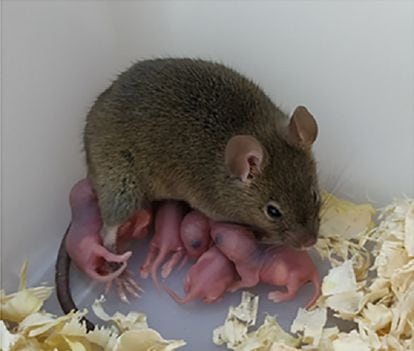Image of the mouse born by asexual reproduction and its offspring.PNAS
Chinese scientists have managed to make a mouse have living children from an unfertilized egg thanks to gene editing.
It would be the first mammal to achieve asexual reproduction, known as parthenogenesis, thanks to this technique.
This Greek term means “virgin creation” and refers to the ability of some animals and plants to reproduce from their own reproductive cells without the need for genetic material from the male.
This phenomenon is relatively frequent in insects and reptiles, for example those that are confined in zoos without males, even in birds.
Until very recently, parthenogenesis was thought to be impossible in mammals.
In 2004, the story of Kaguya, a mouse that was born without the need for sperm or sexual reproduction, was known.
Mammals carry two copies of each gene in our genome, one from the father and one from the mother.
When a sperm enters the egg, there is a phenomenon called genetic imprinting that implies that some genes work differently if they are inherited from the father or the mother.
Many of the genes involved are related to growth, so that by pure evolution it is possible that the genetic imprint of the father favors more growth to have larger offspring and that of the female the opposite to ensure that the pregnancy does not end badly .
Some imprinting genes are also linked to an increased risk of diseases such as cancer.
The Japanese scientists who managed to bring Kaguya into the world used two ovules: one functioned as a real ovule while the other imitated the genetic contribution of the sperm.
The result was a calf that was the son of two females.
The new study, led by Yanchang Wei, a reproductive medicine researcher at Ren Ji Hospital in Shanghai, goes a step further, generating a pregnancy from a single unfertilized egg.
Chinese scientists have used a gene editing technique very similar to CRISPR.
In this case it is not about changing some DNA letters for others, but about making chemical changes on those letters.
These epigenetic changes—on the genome—can turn certain genes on or off.
The authors of the study have used this gene editing tool to mimic genetic imprinting at seven different points in the genome of an egg cell that already had two copies of each gene.
This intervention initiated the biochemical process equivalent to fertilization: the ovum went from being a single cell to a 140-cell blastocyst.
Chinese scientists implanted 192 such embryos into as many other females.
Only one of them was able to give birth to a healthy mouse that survived, although it weighed less than normal – two others died after giving birth.
This last offspring, a female, reached adulthood and was able to reproduce normally.
The researchers emphasize that "parthenogenesis in mammals can be achieved through epigenetic regulation," they write in their study, published in the journal of the US National Academy of Sciences. The team believes that this technique could be perfected so that the successful birth rate is higher.
“The success of parthenogenesis in mammals opens up many possibilities in agriculture, medicine and research”, they add.
“It is a groundbreaking study”, highlights Lluis Montoliu, researcher at the CSIC.
The breakthrough he presents is the use of gene editing to mimic the differential expression of the father's or mother's genes that occurs after conventional fertilization, he adds.
The scientist highlights that the ovules used carried a copy of their genes and another from another ovule of a different species of mouse, with which scientists have been able to verify the effects of editing.
In theory, the development and improvement of this technique could allow children to be generated from a single person, the mother, Montoliu acknowledges.
But the researcher believes that this technique is far from being applied in humans.
“The most important thing now is to follow the life of these mice that were born with these techniques and see if they have no problems living and reproducing;
we have many questions left to answer, ”she highlights.
"This work is a very preliminary first step towards women's reproductive autonomy," says Xavier Vendrell, spokesperson for the Spanish Association of Human Genetics and specialist in reproductive health.
“Translating these results to humans is far from automatic.
In Spain, for example, it would be illegal to keep embryos of this type beyond three days of age.
But it is also that the human genetic imprinting program is much more complex than that of the mouse.
We don't even know all the gene families that are involved,” he stresses.
"They have achieved something fascinating, but terribly inefficient," says David Haig, a researcher at Harvard University.
Years ago, this evolutionary biologist coined a theory about genetic imprinting that basically said that this system had evolved in mammals as a balance between the conflicting evolutionary interests of fathers — who prefer offspring as large as possible — and mothers — that they must receive them in their womb and therefore moderate their growth so that the birth goes well—.
Chinese researchers point out in his work that his research supports Haig's theory.
"This is a new method that may have its advantages," says Mario Conti, a reproductive health expert at the University of California, San Francisco.
One of the authors of the Chinese study, Cai-Rong Yang, worked in her lab until 2019. If gene editing hadn't worked, the embryos would have died within 10 days of gestation, so even getting a single healthy birth is interesting. Conti argues.
Despite this, he warns that it will be necessary to demonstrate if this new method can be perfected.
"It is difficult to predict whether this new method is a revolution or just another step forward," he concludes.
You can follow MATERIA on
,
and
, or sign up here to receive
our weekly newsletter
.







